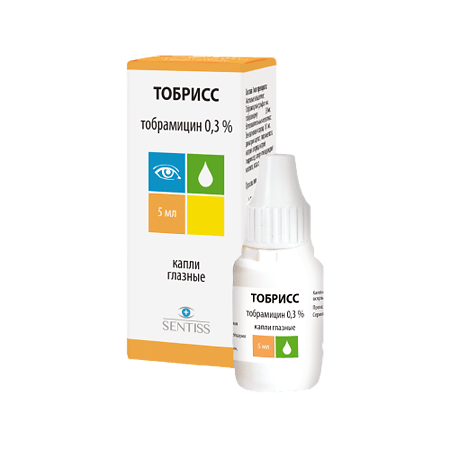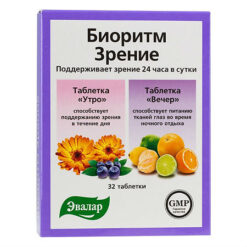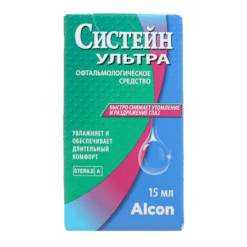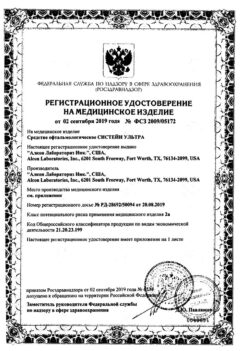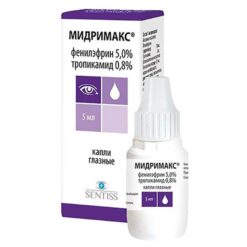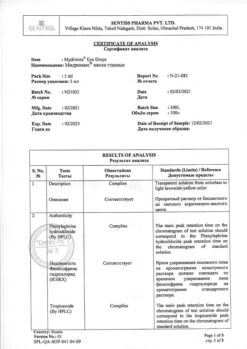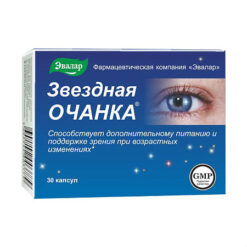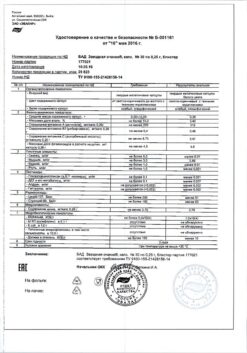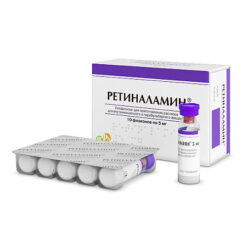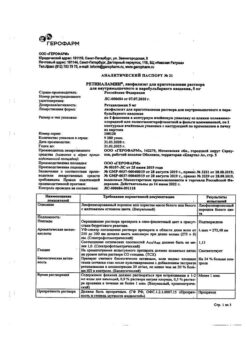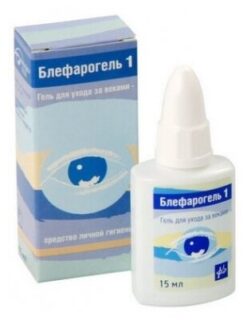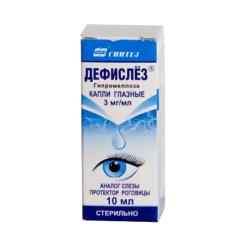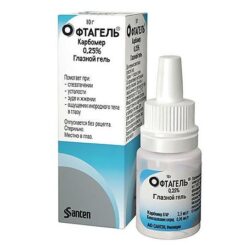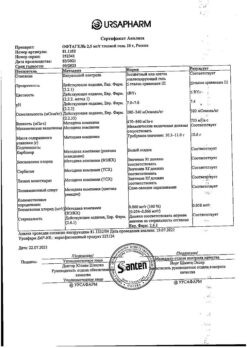No products in the cart.
Tobriss, eye drops 0.3% 5 ml
€4.55 €4.04
Description
an aminoglycoside antibiotic
ATX code: S01AA12
Pharmacological action
.Pharmacodynamics
A broad-spectrum antibiotic of the aminoglycoside group. At low concentrations it is bacteriostatic (blocks 30S ribosome subunit and disrupts protein synthesis), but at higher concentrations it is bactericidal (disrupts protein synthesis and permeability of cytoplasmic membrane of microbial cell, causing its death).
Tobramycin-sensitive microorganisms: Aerobic Gram-positive microorganisms: Corynebacterium, Staphylococcus aureus (methicillin-sensitive); coagulase-negative Staphylococcus species (methicillin-sensitive, including penicillin-resistant strains). Gram-negative bacteria: Acinetobacter species; Escherichia coli; Haemophilus influenzae; Klebsiella species; Moraxella species; Morganella morganii; Pseudomonas aeruginosa.
Tobramycin-resistant microorganisms: Aerobic gram-positive microorganisms: some Staphylococcus species resistant to methicillin with resistance rates of up to 50% of all Staphylococcus species in some European countries; Streptococcus pneumoniae and most strains of group D Streptococci.
Some gentamicin-resistant strains retain high sensitivity to tobramycin.
The emergence of resistance to tobramycin is the result of modification and inactivation of antibiotics by enzymes present in the periplasmic space of bacteria. There are three different mechanisms by which aminoglycosides are inactivated: acetylation of amino groups, phosphorylation of hydroxyl groups and adenylation of hydroxyl groups.
Variable sensitivity between aminoglycoside antibiotics relative to other classes of modified enzymes is also possible. The most common mechanism of acquired resistance to aminoglycosides is inactivation of the antibiotic by plasmid and transposon-encoded enzyme modification.
The following are critical minimum inhibitory concentration (MIC) values that separate sensitive S microorganisms (MIC ≤4mg/ml) from conditionally sensitive microorganisms and conditionally sensitive microorganisms from resistant, R (resistant) ≥8 mg/ml. Resistance can vary geographically for the relevant microbial species, so local information regarding resistant microorganisms is desirable, especially when treating severe infections.
Microorganism | Minimum inhibitory concentration (mg/ml) |
Staphylococcus aureus | 0.2 |
Streptococcus pyogenes | 12.5 |
Streptococcus pneumoniae | 25 |
Pseudomonas aeruginosa | 0.6 |
Escherichia coli | 1.2 |
Klebsiella pneumoniae | 0.8 |
Proteus mirabilis | 1.2 |
Proteus vulgaris | 1.2 |
Proteus morganii | 1.2 |
2.5 | |
Haemophilus | 0.5 |
Neisseria | 5.0 |
Pharmacokinetics
When used topically, systemic absorption is low. Tobramycin poorly penetrates through the cornea and its concentration in aqueous humor after topical administration of 0.3% solution is undetectable. Increasing the frequency of administration may increase the concentration of tobramycin in aqueous humor.
.
Indications
Indications
Treatment of infectious diseases of the anterior segment of the eyeball caused by microorganisms sensitive to tobramycin in adults and children over 2 months.
Pharmacological effect
Pharmacological effect
antibiotic aminoglycoside
ATX code: S01AA12
Pharmacological action
Pharmacodynamics
Broad-spectrum antibiotic from the aminoglycoside group. At low concentrations it acts bacteriostatically (blocks the 30S ribosomal subunit and disrupts protein synthesis), and at higher concentrations it acts bactericidal (disrupts protein synthesis and the permeability of the cytoplasmic membrane of the microbial cell, causing its death).
Microorganisms sensitive to tobramycin: Aerobic gram-positive microorganisms: Corynebacterium, Staphylococcus aureus (sensitive to methicillin); coagulase-negative species of staphylococci (methicillin-sensitive, including penicillin-resistant strains). Gram-negative bacteria: Acinetobacter species; Escherichia coli; Haemophilus influenzae; Klebsiella spp.; Moraxella spp.; Morganella morganii; Pseudomonas aeruginosa.
Tobramycin-resistant microorganisms: Aerobic gram-positive microorganisms: some Staphylococcus species resistant to methicillin with a resistance rate of up to 50% of all staphylococcal species in some European countries; Streptococcus pneumoniae and most strains of group D streptococci.
Some gentamicin-resistant strains remain highly sensitive to tobramycin.
The emergence of resistance to tobramycin is the result of modification and inactivation of antibiotics by enzymes present in the periplasmic space of bacteria. There are three different mechanisms by which aminoglycosides are inactivated: acetylation of amino groups, phosphorylation of hydroxyl groups, and adenylation of hydroxyl groups.
Variable sensitivity between aminoglycoside antibiotics relative to other classes of modified enzymes is also possible. The most common mechanism of acquired resistance to aminoglycosides is inactivation of the antibiotic by modification of plasmids and transposon-encoded enzymes.
Below are the critical minimum inhibitory concentration (MIC) values that separate sensitive microorganisms S (MIC ≤4 mg/ml) from conditionally sensitive microorganisms and conditionally sensitive microorganisms from resistant ones, R (resistant) ≥8 mg/ml. Resistance may vary geographically for relevant microorganism species, so it is desirable to have local information regarding resistant microorganisms, especially when treating severe infections.
Microorganism
Minimum
inhibitory
concentration (mg/ml)
Staphylococcus aureus
0.2
Streptococcus pyogenes
12.5
Streptococcus pneumoniae
25
Pseudomonas aeruginosa
0.6
Escherichia coli
1.2
Klebsiella pneumoniae
0.8
Proteus mirabilis
1.2
Proteus vulgaris
1.2
Proteus morganii
1.2
Proteus rettgeris
2.5
Haemophilus
0.5
Neisseria
5.0
Pharmacokinetics
When applied topically, systemic absorption is low. Tobramycin penetrates the cornea poorly, and its concentration in the aqueous humor after topical application of a 0.3% solution is not determined. Increasing the frequency of use may increase the concentration of tobramycin in aqueous humor.
Special instructions
Special instructions
For topical use in ophthalmology only. The drug is not intended for injection or oral use.
Hypersensitivity to aminoglycosides for topical use in ophthalmology has been noted in a number of patients. If hypersensitivity symptoms develop, discontinue use of the drug. Cross-sensitivity to other aminoglycosides has been noted, so it must be taken into account that in case of hypersensitivity to tobramycin, hypersensitivity to other aminoglycosides for topical or systemic use is possible.
Serious adverse reactions such as neurotoxicity, ototoxicity and nephrotoxicity have been reported with oral administration of tobramycin. Caution is required when used together with other aminoglycosides. As with long-term use of other antibiotics, excessive growth of microorganisms insensitive to tobramycin, including fungi, is possible. If superinfection develops, use of the drug must be discontinued.
It is not recommended to wear contact lenses during the treatment of infectious diseases of the organ of vision.
This product contains benzalkonium chloride, which may cause eye irritation and discolor soft contact lenses. Contact of the drug with soft contact lenses should be avoided. Patients should be instructed to remove contact lenses before using the drug and to put them back on no earlier than 15 minutes after instillation.
Active ingredient
Active ingredient
Tobramycin
Composition
Composition
Each ml of the drug contains:
Active substance: tobramycin – 3 mg.
Excipients:
Benzalkonium chloride 0.1 mg, hypromellose 2.5 mg, disodium edetate 1.0 mg, sodium chloride 9.0 mg, sodium hydroxide or hydrochloric acid to pH 7.5, water for injection up to 1 ml.
Pregnancy
Pregnancy
Fertility
There have been no clinical studies examining the effects of tobramycin eye drops on fertility in humans.
Pregnancy
When tobramycin was administered orally in doses significantly higher than those for use in the form of instillations, nephro- and ototoxicity were observed. Tobramycin, when administered orally, penetrates the placenta into the amniotic fluid and fetal blood. In a study of parenteral aminoglycoside antibiotics, including tobramycin, no risk to the fetus was noted. High plasma levels of tobramycin are not expected following instillation administration.
There is no or limited information on the use of the drug in the treatment of pregnant women. Animal studies provide evidence of reproductive toxicity. The use of the drug during pregnancy is not recommended.
Breastfeeding period
Tobramycin is excreted into breast milk in significant quantities after oral and parenteral administration. When used as instillations, the systemic exposure of the drug is low, which makes excretion of tobramycin into breast milk unlikely. It is necessary to stop breastfeeding or interrupt/discontinue drug therapy, taking into account the benefits of therapy for the mother and the benefits of breastfeeding for the child.
Contraindications
Contraindications
Hypersensitivity to the components of the drug, breastfeeding period, children under 2 months of age.
Side Effects
Side Effects
The most common adverse events when using the drug were toxicity and local hypersensitivity, including itching of the eyelids, swelling of the eyelids, lacrimation, conjunctival injection.
Information on adverse events was obtained during clinical trials and post-registration experience with the drug and classified according to the following frequency gradation: very common (> 1/10), common (from > 1/100 to 1/1,000 to 1/10,000 to < 1/1,000), very rare (< 1/10,000), unknown frequency (frequency cannot be determined) determined based on available data). Within each group of adverse events, grouped according to frequency of occurrence, adverse events are presented in descending order of severity.
Immune system disorders
Uncommon: hypersensitivity.
Nervous system disorders
Uncommon: headache.
Visual disorders
Often: discomfort in the eye, conjunctival injection, allergic phenomena from the organ of vision, itching of the eyelids; uncommon: keratitis, corneal erosion, blurred vision, blurred vision, eyelid erythema, eye discharge, conjunctival edema, eyelid swelling, eye pain, dry eye syndrome, eye itching, lacrimation; with unknown frequency: eye irritation.
Skin and subcutaneous tissue disorders
Uncommon: urticaria, dermatitis, madarosis, leucoderma, itching, dry skin; with unknown frequency: rash, erythema.
Interaction
Interaction
No studies have been conducted on the interaction of the drug with other drugs. When combined with ophthalmic forms of tobramycin and corticosteroids for topical use in ophthalmology, the clinical symptoms of bacterial, fungal and viral diseases of the organ of vision can be masked, as well as hypersensitivity reactions can be suppressed.
Overdose
Overdose
No toxic effects are expected from topical ophthalmic use of the drug or in case of accidental ingestion of the contents of the bottle. Clinical manifestations of overdose when using tobramycin in the form of instillations (including punctate keratitis, erythema of the eyelids, lacrimation, conjunctival edema, itching of the eyelids) may be similar to the adverse events that were observed in a number of patients during treatment with the drug.
Storage conditions
Storage conditions
Store at a temperature not exceeding 25°C in a place protected from light. Do not freeze.
Keep out of the reach of children.
Shelf life
Shelf life
2 years.
30 days after opening the bottle.
Do not use after the expiration date stated on the package.
Manufacturer
Manufacturer
Sentiss Pharma Pvt.Ltd, India
Additional information
| Shelf life | 2 years. 30 days after opening the bottle. Do not use after the expiration date stated on the package. |
|---|---|
| Conditions of storage | Store at a temperature not exceeding 25 ° C in a light-protected place. Do not freeze. Keep out of reach of children. |
| Manufacturer | Sentiss Pharma Pvt.Ltd, India |
| Medication form | eye drops |
| Brand | Sentiss Pharma Pvt.Ltd |
Related products
Buy Tobriss, eye drops 0.3% 5 ml with delivery to USA, UK, Europe and over 120 other countries.

